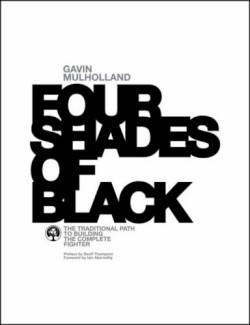
Four Shades of Black
The Traditional Path to Building the Complete Fighter
Four Shades of Black is a feast for the eyes. The stark black pages with brilliant white text and lush monochrome photography are worthy of any coffee table art volume. This tome is no commonplace karate book; it illuminates the traditional path to becoming a complete fighter in a unique and exciting way.
British Combat Association Hall of Fame member Gavin Mulholland does a fantastic job of showing how karate was developed as a complete and comprehensive fighting system, with kata (formal exercises) as the map and gradings as the compass to developing real-life fighting skills in a logical progression that builds from kata to kata throughout the curriculum. He ties seemingly together disparate kihon (fundamental basics), bunkai (fighting applications), conditioning exercises, padwork, and partner drills to demonstrate a complete package that helps practitioners ingrain the essential teachings of four Goju Ryu karate kata.
Goju Ryu is an Okinawan empty-hand fighting style that blends both hard and soft techniques. The key to learning this system is understanding its kata, four of which are explained in the book: gekisai dai ichi, gekisai dai ni, saifa, and seiyunchin. Gekisai dai ichi roughly translates as “attack and smash number one.” It is generally the first form taught to new practitioners, hence utilizes a straightforward blitzing-style approach. Gekisai dai ni is the second kata of this series, showing more refined, non-linear movements and advanced open-hand techniques. While gekisai is a fairly modern kata, saifa is an ancient form that essentially means “smash and tear.” Seiyunchin can be translated as “trapping battle,” a grappling/close-quarter fighting form.
Each of these four kata is examined thematically, showing the principle, mindset, and applicable area of combat stressed by the form. Fascinating vignettes at the beginning of these sections give readers a real-life image of their utility as well. This approach breathes life into the text, helping readers visualize all the essential elements in a way that makes it easier to practice them on the dojo (training hall) floor.
Although some of the examples used to demonstrate the bunkai are not necessarily the optimum applications for use in a street fight, they do serve to highlight the themes and principles of the kata they represent. Since the goal of the book is not so much deciphering fighting applications from kata, but rather demonstrating the holistic fighting system and logical progression of the art, this is easily forgiven.
Mulholland is an extraordinarily skillful practitioner with more than thirty years of training under his belt. He has honed his fighting prowess working the doors of pubs and clubs throughout the United Kingdom. Readers can truly feel this experience in his writing. The book transcends the training hall, bringing modern utility to the ancient art of karate. It is a well-written, unique, and interesting tome that should appeal to most any karateka, but especially Goju Ryu practitioners.
Disclosure: This article is not an endorsement, but a review. The publisher of this book provided free copies of the book to have their book reviewed by a professional reviewer. No fee was paid by the publisher for this review. Foreword Reviews only recommends books that we love. Foreword Magazine, Inc. is disclosing this in accordance with the Federal Trade Commission’s 16 CFR, Part 255.
